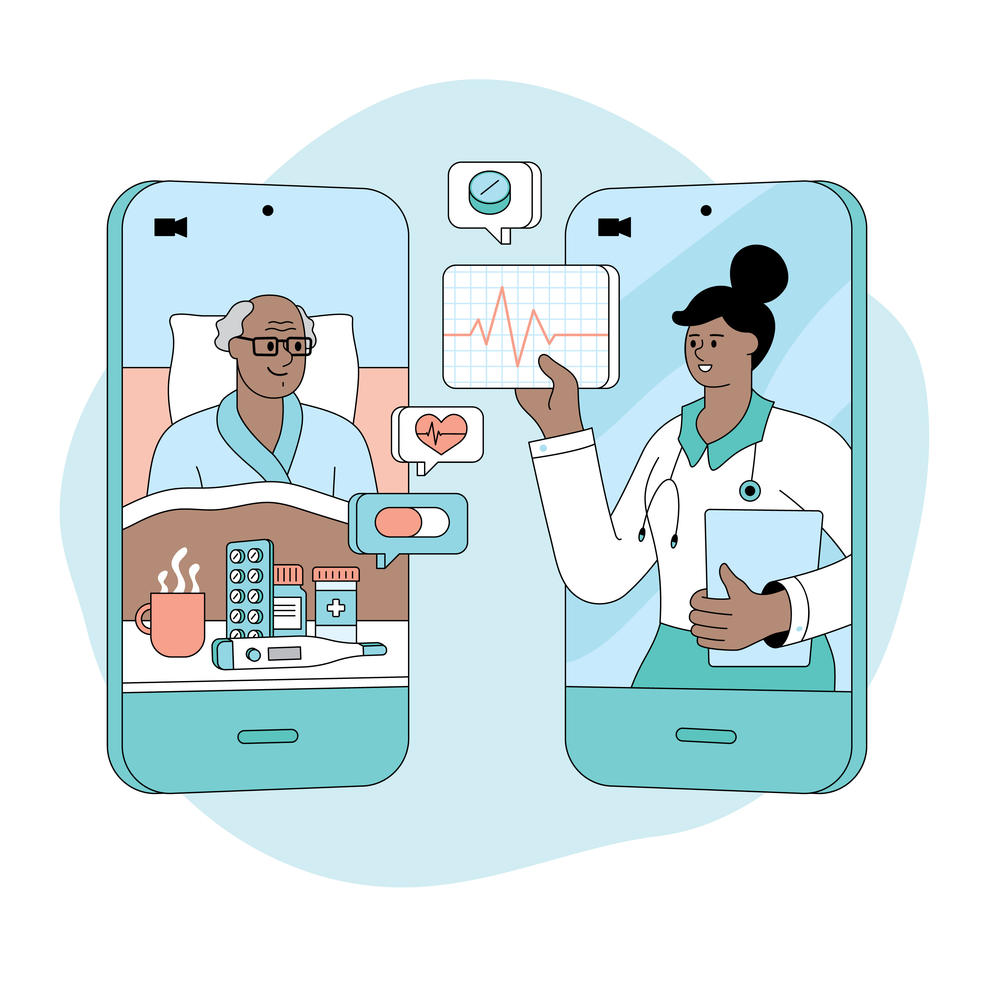Section Branding
Header Content
Patients say telehealth is OK, but most prefer to see their doctor in person
Primary Content
New Yorker Charlie Freyre's sinuses had been bothering him for weeks last winter, during a COVID-19 surge in the city. It was before vaccines became widely available.
"I was just trying to stay in my apartment as much as possible," Freyre says, so checking in with his doctor via an online appointment "just seemed like a more convenient option. And you know, it was very straightforward and very easy."
The $20 copay was well worth it for the 26-year-old ad salesman, whose girlfriend also routinely relies on telehealth to see her nutritionist. "It's a very easy way to get an expert opinion without having to necessarily leave your apartment," fill out forms or spend idle time in waiting rooms, Freyre says. "We all know what going to the doctor can be like."
But now, Freyre has a sore knee — and he's not content to to visit his doctor by phone or Zoom. "That's something that I will 100% want handled in person."
Freyre's telehealth experience is fairly typical. Telehealth is continuing to have its breakout moment — transforming the way we receive routine medical care during the pandemic, when visiting medical centers has carried with it the risk of coronavirus infection. Yet even today, with that infection risk easing for those who have been vaccinated, many patients nevertheless prefer that doctors, nurses and other health workers be able to examine and talk to them in person.
That's one finding from a poll by NPR, the Robert Wood Johnson Foundation and the T.H. Chan School of Public Health at Harvard that surveyed patients in August and September. Around 42% of respondents said someone in their household had used telehealth. Of those, 82% reported satisfaction, yet nearly two-thirds — 64% — would have preferred to see their nurse or doctor in person.
In-person visits can be more thorough
"I think people just really like that face-to-face visit," says Rebekah Bernard, a Fort Myer, Fla., family physician, and a board member of Physicians for Patient Protection, which advocates for better patient care. Bernard, who runs a concierge medical practice that charges patients a flat monthly fee for services, says she started offering telehealth options to her patients five years ago, long before COVID-19 hit U.S. shores. Back then, not one of her patients used it. That changed during the pandemic, when patients told her having the telehealth option allayed their worries about getting safe access to health care.
That sort of shift in acceptance and how it's used may have big implications for telehealth's role in the U.S. in the future. It's use by various physical and mental health specialties grew tremendously in 2020, as federal and state governments and insurance companies adopted emergency COVID-19 measures, relaxing restrictions on coverage, privacy controls and professional licensing, for example. Now, some of those rules regarding telehealth appointments are being reinstated.
Bernard, the physician in Florida, says the last year has also shown her the limits and downsides of telehealth: "You may be missing that opportunity to be talking with the doctor who's going to say, 'Hey, by the way, I see you haven't had your mammogram or you haven't had your pap [smear].' "
Both she and most patients prefer in-person visits, because it is both more personal, thorough and ultimately, she says, better for the patients' health.
A lifeline in rural areas
But when and where such visits aren't available, she says, telehealth can be critical. "What's going to be important is offering patients options and finding out what makes the most sense in a certain area," she says. "I'm sure in rural areas or places where, for example, they don't have a lot of specialists like psychiatrists, we really need to make sure we have access to telehealth for those patients."
Myriad telehealth companies are already investing to make that happen.
New York City-based TytoCare, helps medical centers and doctors gather data on patients remotely by distributing devices that can sensitively measure patients' oxygen levels or take images of the inside of their throat, for example. David Bardan, a vice president at TytoCare, says that data is then transmitted to doctors, who use it diagnose medical problems.
Nursing homes in rural areas, for example, are heavy users of the service, he says. "This is way more convenient than having to potentially air-transport or even having to drive long distances, in many cases, to access those specialists," he says. That's the sort of circumstance where telehealth excels, Barden says — and he believes those applications of telehealth will endure.
Copyright 2021 NPR. To see more, visit https://www.npr.org.

